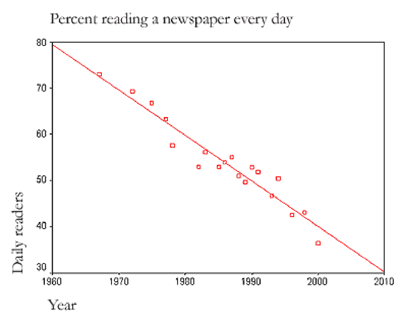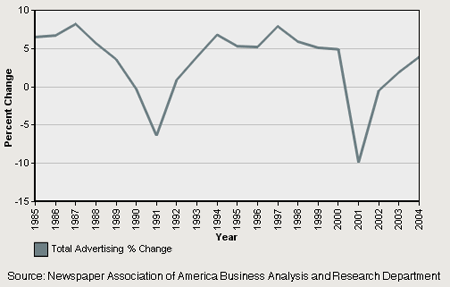Enter the Web
During Smith's first year as managing editor (the second most senior newsroom position), the newspaper industry still believed itself on solid financial ground. Although national newspaper circulation had been in gradual decline for over 10 years, advertising dollars generated by a 1990s technology boom had counterbalanced—and effectively masked—the losses. Many newspapers established online versions of their print product, but paper executives did not yet see the medium as a viable alternative for their readers, or as a threat to traditional streams of advertising revenue. For many executives, the rising cost of newsprint and a public too busy to read caused more alarm than the newly emerging phenomenon called the Internet.
But by 1997, the Web began to put pressure on newspapers' profits from classified ads. That year, Microsoft Corporation launched a Web-based daily newspaper called Sidewalk . Newspapers took notice, refused to provide Microsoft with content needed for the venture, and in the end Sidewalk failed. But the following year, two Stanford University students introduced Google, a search engine that allowed Internet users to find local events, classified advertising, and news—information traditionally provided by newspapers—with newfound ease. In the following years, it became hard to ignore Internet newcomers such as ebay.com (online auctions) and craigslist.com (free classifieds) that suddenly posed competition for revenues that had long belonged almost exclusively to newspapers.
It was far from clear, however, just how traditional newspapers could take advantage of the emerging technology—or whether they should. Discussions and predictions about the Internet and newspapers filled journalism magazines and emerged as a hot topic at industry conferences. At a 1998 University of California at Berkeley conference on journalism, industry experts talked about the promise and the threat of "new media." A columnist from the San Jose Mercury News told a panel that newspapers "...are going to have to just deal with it and recognize that the convergence of media forces is upon us." [3]
By the late 1990s, newspapers were becoming increasingly concerned about the future of their medium, realizing that what was being called the Internet revolution was not just hype. By 1999, 60 percent of papers with less than 500,000 readers had lost circulation. Weekday circulation remained at essentially the same level as 1955, even though national population had grown 64 percent over the same period. [4] As a former reporter wrote in the American Journalism Review , some of the reasons for the industry's circulation decline were beyond the control of individual publications. Changing lifestyles, with greater emphasis on out-of-home activities, made it more difficult for people to make time for a newspaper. Many dailies merged or closed while competition grew from broadcast, weekly publishing and, increasingly, the Internet. [5]
A 2004 book by Philip Meyer called The Vanishing Newspaper: Saving Journalism in the Information Age mirrored even greater soul-searching in the newspaper industry. [6] If one were to project forward from current circulation levels, Meyer predicted, the last ink-on-paper reader would give up the newspaper in April 2040. Part of the problem, Meyer wrote, was that in the new media world, the attention span of would-be readers was shrinking by the day. "In the cluttered information marketplace, where information itself is no longer scarce and therefore less valued," Meyer wrote, "the attention of the public has become the scarce good."
Declining readership

Source:
General Social Survey, National Opinion Research Center, University of Chicago. Graph by Philip Meyer
Nationwide, newspapers experienced their worst years in 2000-2002. The boom of the Internet economy in the late 1990s meant newspapers had enjoyed healthy advertising revenue, fueled by start-up companies which paid for classified ads to find employees and spent large advertising budgets in print mediums. But when the "dot.com bubble"—the Internet economy—collapsed at the beginning of the 21st century, those technology companies drastically curtailed advertising, and newspapers lost a source of revenue that had counterbalanced the losses from declining subscriptions. Advertising revenue dropped over 9 percent between 2000 and 2002, representing an historic $5 billion loss to the newspaper industry. The hardest hit area was help-wanted ads, which dropped by half in the same period. [7]
Change in advertising revenue

The Web, meanwhile, did not seem capable of helping newspapers replace their shrinking revenues from the print product. While the surge in traffic to news websites after the terrorist attacks of September 11, 2001, proved the Internet to be a popular and valid news medium, no one had figured out how to make newspaper websites profitable. Some newspapers tried asking readers to pay for news online, but most ended the approach when readers migrated to free news sites instead. Some advertisers considered shifting their advertising to newspapers' websites, but few were willing to pay much for online ads without a clear understanding of how many potential customers these ads would reach or what impact they would have. For a time, it looked as if the dire future predicted by EPIC 2014 —a fictional newsreel in which Google, Amazon, and an army of amateurs eventually drive out even the New York Times —was not so far-fetched.
Footnotes
[3] Comment made by Dan Gillmor at the 1998 Conference on Excellence in Journalism and the New Media, University of California Berkeley School of Journalism. See transcript .
[4]
Audit Bureau of Circulations, Report on Nation's Newspapers, May, 1999. For more information: Felicity Barringer. "
Newspaper Industry Fails to Stem Circulation Drop.
"
New York Times
, May 4, 1999.
[5] John Morton. "Bad news about newspaper circulation." American Journalism Review , July/August 1999.
[6] Philip Meyer. The Vanishing Newspaper: Saving Journalism in the Information Age . University of Missouri Press: 2004. Meyer was Knight Chair in Journalism at the University of North Carolina.
[7] Comments from Tony Ridder, chairman and CEO of Knight Ridder, October 8, 2003, at the National Press Club.